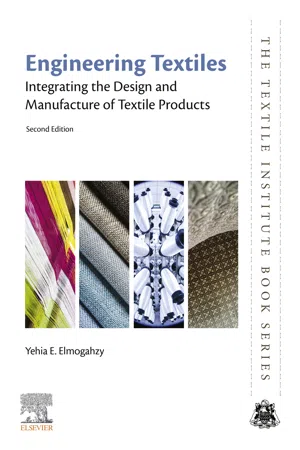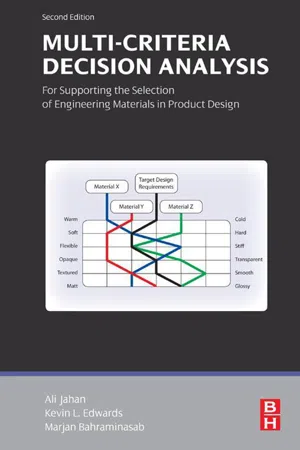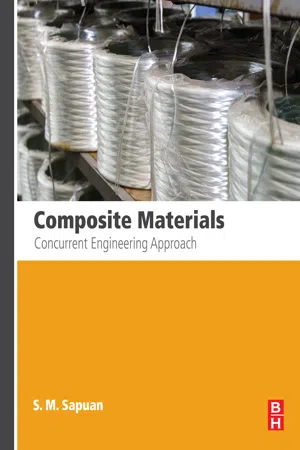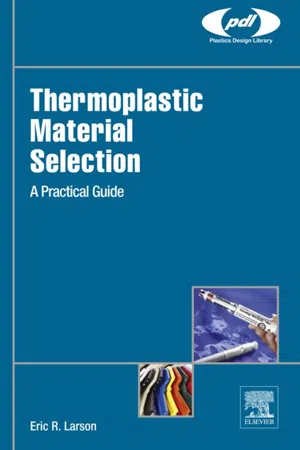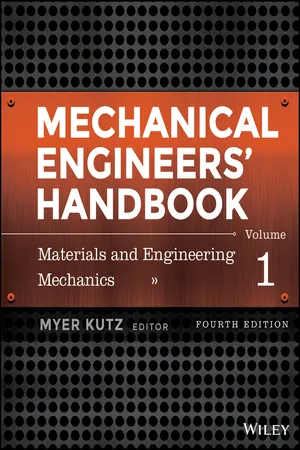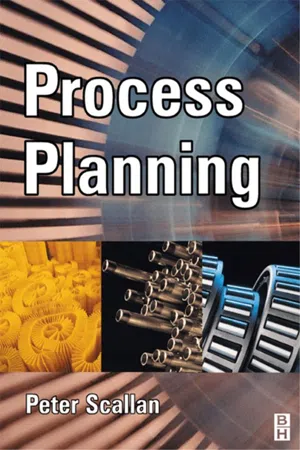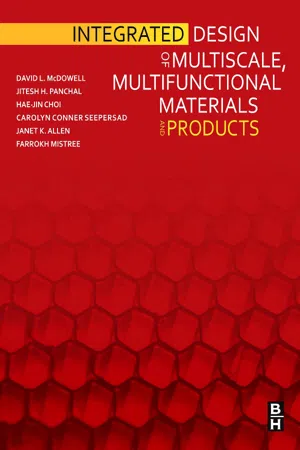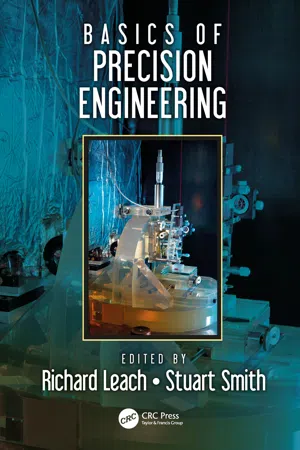Technology & Engineering
Materials Selection
Materials selection is the process of choosing the most suitable materials for a specific engineering application. It involves considering factors such as mechanical properties, cost, availability, and environmental impact to ensure that the chosen materials meet the requirements of the design. This process is crucial for achieving optimal performance, durability, and cost-effectiveness in engineering projects.
Written by Perlego with AI-assistance
Related key terms
Related key terms
1 of 4
Related key terms
1 of 3
10 Key excerpts on "Materials Selection"
- eBook - ePub
Engineering Textiles
Integrating the Design and Manufacture of Textile Products
- Yehia Elmogahzy(Author)
- 2019(Publication Date)
- Woodhead Publishing(Publisher)
7Material selection
Abstract
Material selection represents the most critical aspect of design engineering. Understanding material structure, properties, and processing represents a common knowledge base between scientists, engineers, and technologists. Many design problems are solved either by selecting raw materials of better attributes or by changing the type of material used. The fact that material can be stiff, strong, ductile, brittle, tough, or hard provides numerous design options that are suitable for a wide range of end products. Since raw material makes up the building blocks of all manufacturing processes, the choice of one raw material versus another could mean substantial cost reduction. This point is very common in textile technology in which manufacturing cost is often minimized by the choice of an appropriate fiber type or blending fibers of different prices at predetermined ratios and under quality constraints. In this chapter, basic steps of material selection in design applications are discussed. The key tasks of evaluating material candidates for a certain product are reviewed. These include (a) knowledge of the common material categories (i.e., screening category), (b) understanding basic material properties (i.e., screening property), (c) determining the optimum cost of material with respect to its performance and its contribution to the value of the end product, (d) understanding the effects of technology on material selection, and (e) understanding the differences between design-direct and value-impact performance characteristics. Many examples of fibrous materials are presented in the context of these tasks. - eBook - ePub
Informatics for Materials Science and Engineering
Data-driven Discovery for Accelerated Experimentation and Application
- Krishna Rajan(Author)
- 2013(Publication Date)
- Butterworth-Heinemann(Publisher)
Chapter 10Materials Selection for Engineering Design
Michael Ashby* , Elizabeth Cope† and David Cebon‡ ,* Emeritus Professor, Cambridge University Engineering Department, Cambridge, UK,† Granta Design Limited, Cambridge, UK,‡ Cambridge University Engineering Department, Cambridge, UK1 Introduction
Material properties limit product performance. For optimized, innovative engineering design, we need systematic procedures and informatics to select them. This is about more than just ranking materials according to a particular material property, but about assessing the entire profile of properties that will maximize performance – performance, here, meaning technical excellence at acceptable cost and minimum environmental intrusion.Figure 10.1 A systematic material selection strategy.2 Systematic Selection
2.1 Translation
Any engineering component has one or more functions : To support a load, to contain a pressure, to transmit heat, and so forth. This must be achieved subject to constraints : That certain dimensions are fixed; that the component must carry the design loads without failure or excessive deflection; the need to insulate against or to conduct heat or electricity; to function in a certain range of temperature or in a given environment; and many more.In designing the component, the designer has one or more objectives : To make it as cheap as possible, perhaps, or as light, or as environmentally benign, or some combination of these. Certain parameters can be adjusted in order to optimize the objective – the designer is free to vary dimensions that are not constrained by design requirements and, most importantly, free to choose the material for the component and the process to shape it. We refer to these as free variables - eBook - ePub
- Ali Jahan, Kevin L Edwards, Marjan Bahraminasab(Authors)
- 2016(Publication Date)
- Butterworth-Heinemann(Publisher)
The selection of the most appropriate material for a particular purpose is a crucial function in the design and development of products. Materials influence product function, customer satisfaction, production systems, product life cycle, who is going to use or produce it, usability, product personality, operating environment, and costs in a complex way.Materials Selection can be carried out to either choose alternative materials for changes to the design of an existing product in order to reduce say cost or weight, meet new legal requirements, overcome failure occurrence, or satisfy different market demands, or it can be used to choose materials for the design of a completely new product. The Materials Selection process is similar for existing and new products although the starting point and information requirements may differ. The interdisciplinary effort required in most cases is nontrivial and the engineering designer not only requires detailed, accessible, and timely information about materials’ properties but also knowledge of multi-criteria decision-making (MCDM).This book describes the main principles and strategic application of MCDM techniques to support engineering product designers compare the performance of established materials, hybrid materials, and new materials, when selecting the most appropriate materials for new product design.1.2 Background and justification for formalized Materials Selection
There are an enormous number of materials available, each with a range of different properties and behaviors. New materials are also constantly being developed with enhanced properties, expanding the list of options available to the engineering designer. The materials’ properties, and combination of properties in the form of performance indices, can be mapped on to materials’ selection charts, pioneered by Ashby (2013) . In the charts, the materials naturally cluster into the different classes of metals, polymers, elastomers, glasses, and ceramics. However, only parts of the charts are populated with materials, leaving holes or gaps in the selection space. New materials with enhanced properties can reduce the size of or fill gaps within clusters, or expand the boundary of clusters, or the gaps between clusters can potentially be filled or “bridged” with hybrid or multi-materials such as composite materials as shown schematically in Fig. 1.1 - eBook - ePub
Composite Materials
Concurrent Engineering Approach
- S. M. Sapuan(Author)
- 2017(Publication Date)
- Butterworth-Heinemann(Publisher)
The range of materials available to design engineers is wide and constantly increasing. This poses a huge challenge to design engineers. For instance, during the selection process, a material or materials must satisfy a complex set of design requirements and must be at the same time, cost-effective to be a successful candidate. The fundamental questions are which material is the most suitable and can the selected material satisfy the imposed requirements. In Materials Selection, a design engineer must thoroughly understand and be familiar with the properties of various materials to satisfy the requirements of the design.The use of material handbooks is a traditional method of performing Materials Selection. The use of computerized Materials Selection system has the added advantage of encouraging design engineers to consider and analyze their requirements for a material. It could be in the form of materials databases, Ashby charts, or any computerized Materials Selection tools. In recent years, Materials Selection has become too complicated to manage without the help of any tools and selecting the incorrect materials may incur financial and other losses. Thus, it is hard to see how design engineers can optimize their choices without some form of computerized selection tool.Materials Selection should be conducted from the conceptual design stage of the design process. The selection must continue during the embodiment design stage and finally during detail design stage, Materials Selection still has to be performed. The only difference between these three stages of design is that the candidate materials are different. During the conceptual design stage, the number of candidate materials is enormous, and the criteria that define the properties of candidate materials are normally quite vague. During the embodiment design stage, the number of candidates is reduced and finally during detail design, only a few candidate materials are available for selection. During the latter two stages of the design process, the Materials Selection criteria should be further developed and refined. - eBook - ePub
- Ali Jahan, Kevin L Edwards(Authors)
- 2013(Publication Date)
- Butterworth-Heinemann(Publisher)
Chapter 1 The Importance of Decision Support in Materials Selection1.1 Introduction to Materials Selection
The selection of the most appropriate material for a particular purpose is a crucial function in the design and development of products. Materials influence product function, customer satisfaction, production systems, product life cycle, who is going to use or produce it, usability, product personality, operating environment, and costs in a complex way.Materials Selection either can be carried out to choose alternative materials for changes to the design of an existing product in order to reduce say cost or weight, meet new legal requirements, overcome failure occurrence, or satisfy different market demands, or it can be used to choose materials for the design of a completely new product. The Materials Selection process is similar for existing and new products although the starting point and information requirements may differ. The interdisciplinary effort required in most cases is nontrivial and the engineering designer not only requires detailed, accessible, and timely information about the properties of the materials but also knowledge of multi-criteria decision-making (MCDM).This book describes the main principles and strategic application of MCDM techniques to support engineering designers compare the performance of established materials, new materials, and hybrid materials when selecting the most appropriate materials for product design.1.2 Background and Justification for Formalized Materials Selection
There are an enormous number of materials available, each with a range of different properties and behaviors. New materials are also constantly being developed with enhanced properties, expanding the list of options available to the engineering designer. The material properties, and combination of properties in the form of performance indices, can be mapped on to materials’ selection charts, pioneered by Ashby [1] . In the charts, the materials naturally cluster into different classes of metals, polymers, elastomers, glasses, and ceramics. However, only parts of the charts are populated with materials, leaving holes or gaps in the selection space. New materials with enhanced properties can reduce the size or fill gaps within clusters, or expand the boundary of clusters, or the gaps between clusters can potentially be filled or “bridged” with hybrid or multimaterials such as composite materials, as shown schematically in Figure 1.1 - eBook - ePub
Thermoplastic Material Selection
A Practical Guide
- Eric R. Larson(Author)
- 2015(Publication Date)
- William Andrew(Publisher)
Then, as one begins to evaluate materials, one must consider chemical families, grades, versions, property data (and/or the lack thereof), testing and verification, agency approvals, sourcing and supply chain issues, and proper processing. Sadly, many engineers and designers short circuit the selection process by jumping immediately into property data, combing databases and material data sheets to find the highest value of one specific property in order to determine the best material for the application.However, material selection is not about finding the “best” possible material for an application. Rather, it is about finding one or more suitable materials that—in combination with an effective design, proper processing, and eventual integration into a final system—result in a product that meets its intended use and satisfies (and hopefully delights) the needs of the end user. Far too often, in our quest to find the best material, we often forget that the real goal is to make the best possible product.The ultimate goal of effective material selection is to optimize the performance of the product itself. While this may seem like a trivial statement, it is an important one.5.1. What is Performance?
Performance is another one of those words that has a number of different meanings. In engineering, it is commonly used to describe the function of a system and how well it achieves its intended purpose.When we talk about product performance, we are referring to an overall assessment of a product based on an evaluation of a number of measured parameters. For example, for an automobile we may measure acceleration, handling on the road, cornering, roominess of the interior, the sound levels while driving, and riding comfort. The performance criteria for a race car will be distinctly different than for a family sedan, or for a sports coupe. For sports equipment we may measure weight, stiffness, handling at high speed, vibration characteristics, the feel in our hands, as well as output at specific loading conditions (e.g., the launch angle and spin rate of a golf ball when struck by the clubhead of a driver at a specific head velocity). For a medical device we may measure the reliability and consistency of its operation under a wide variety of use scenarios, including mis-use (unintended or intentional). - eBook - ePub
Mechanical Engineers' Handbook, Volume 1
Materials and Engineering Mechanics
- Myer Kutz, Myer Kutz(Authors)
- 2015(Publication Date)
- Wiley(Publisher)
The environment in which the product or part will operate plays an important role in determining the material performance requirements. Corrosive environments, as well as high or low temperatures, can adversely affect the performance of most materials in service. Whenever more than one material is involved in an application, compatibility becomes a selection consideration. In a thermal environment, for example, the coefficients of thermal expansion of all the materials involved may have to be similar in order to avoid thermal stresses. In wet environments, materials that will be in electrical contact should be chosen carefully to avoid galvanic corrosion. In applications where relative movement exists between different parts, wear resistance of the materials involved should be considered. The design should provide access for lubrication; otherwise self-lubricating materials have to be used.2.2 Quantitative Methods for Initial Screening
Having specified the performance requirements of the different parts, the required material properties can be established for each of them. These properties may be quantitative or qualitative, essential or desirable. For example, the function of a connecting rod in an internal combustion engine is to connect the piston to the crankshaft. The performance requirements are that it should transmit the power efficiently without failing during the expected life of the engine. The essential material properties are tensile and fatigue strengths, while the desirable properties that should be maximized are processability, weight, reliability, and resistance to service conditions. All these properties should be achieved at a reasonable cost. The selection process involves the search for the material or materials that would best meet those requirements. In some cases none of the available materials can meet the requirements or the possible materials are too expensive or environmentally unsafe. In such cases, alternatives must be made possible through redesign, compromise of requirements, or development of new materials.Generally, the starting point for Materials Selection is the entire range of engineering materials. At this stage, creativity is essential in order to open up channels in different directions, not let traditional thinking interfere with the exploration of ideas, and ensure that potential materials are not overlooked. A steel may be the best material for one design concept while a plastic is best for a different concept, even though the two designs provide the same function. - eBook - ePub
Process Planning
The Design/Manufacture Interface
- Peter Scallan(Author)
- 2003(Publication Date)
- Butterworth-Heinemann(Publisher)
4 Material evaluation and process selection 4.1 Introduction In Chapter 1, manufacturing was defined in terms of transforming raw materials into a product. The selection of a specific material for a particular part or product is an important part of the design and manufacture cycle. It is the responsibility of the design function, not only to design a product that meets the specific need, but also to select the correct material for the part or product. However, once specified, the selection of a specific material ultimately limits the manufacturing processes that can be used. It is important to recognize that the material and process selections are not made from a limitless range and are in fact limited by the products manufactured, and the materials and processes available, within an organization. Generally, the role of manufacturing is to evaluate the material selected at the design stage. In some instances, this evaluation may lead to an alternative material being suggested by manufacturing and thus a meaningful dialogue must be entered into with the designers. Reasons for specifying such an alternative might include poor manufacturability (leading to high manufacturing costs) and high costs of the material itself. To enter into such a dialogue, manufacturing must have a good knowledge of the materials available and their associated properties, in addition to their suitability for specific manufacturing processes. Therefore, it can be seen from the above that the selection of materials is closely linked to the selection of appropriate manufacturing processes - David L. McDowell, Jitesh Panchal, Hae-Jin Choi, Carolyn Seepersad, Janet Allen, Farrokh Mistree(Authors)
- 2009(Publication Date)
- Butterworth-Heinemann(Publisher)
Finally, in Section 4.3, the fundamentals of utility theory as embodied in the decision support constructs embraced by Mistree and coauthors are described as a means of mathematically formulating design decisions in the presence of uncertainty. Figure 4.1 Overview of Chapter 4 and its relationship with other chapters in the book. 4.1. Designing—A Goal-oriented Activity There appear to be several common notions regarding the meaning of design as it involves development and selection of materials. First, there is the concept that design involves selection of the best material for a given application. This perspective focuses attention on material properties since design engineers are accustomed to communicating with materials engineers and developers on the basis of property sets. The Granta LTD Materials Selector Software by Ashby and coauthors (Granta Design Limited 2007) is a prime example. It has been widely employed in undergraduate mechanical, aerospace, civil and materials science, and engineering departments across the globe for instruction in Materials Selection in design. As discussed in Chapter 1, Materials Selection is just one aspect of the overall materials design problem. A second common notion is that materials design comprises the optimization of properties or responses obtained from a certain set of material process-structure and/or structure-property simulations in which material microstructure is varied. This notion often compels development of complex, concurrent multiscale models since optimization intrinsically conveys the need for high accuracy of the modeling scheme. It is often pursued by the engineering science community, which employs various micromechanics modeling tools. In reality, only certain limited subproblems are typically amenable to optimization, with the shortcoming that overall system response cannot be optimized in general by independent optimization of subsystems- eBook - ePub
- Richard Leach, Stuart T. Smith, Richard Leach, Stuart T. Smith(Authors)
- 2018(Publication Date)
- CRC Press(Publisher)
12 Materials Selection in Precision Mechanics Derek G. Chetwynd12.1 Drivers for Materials Choice in Precision Engineering12.1.1 Introductory Comments12.1.2 Top-Level Requirements12.2 Design of Materials: A Brief Overview12.2.1 Major Classes of Materials12.2.2 Microstructure and Properties12.2.3 Non-Mechanical Properties12.3 Classifications for Materials Selection Criteria12.3.1 Setting Up Comparison Schemes12.3.2 Properties and Behaviour under Stress12.3.3 Thermal Properties and Behaviour12.4 Materials for Precision Engineering: Common and Interesting Choices12.4.1 Metallic Materials12.4.2 Ceramics and Glassy Materials12.4.3 Polymeric and Composite Materials12.4.4 Esoteric and Emerging Materials12.4.5 Final Comments: Properties and Practical Design ChoicesAppendix Exercises ReferencesMaterials science and technology is a major field of study, still rapidly developing, and clearly a book such as this one cannot and should not try to address it in great breadth or depth. Yet, it is not possible to design and build any physical structure without influence from its materials’ properties. Choice of materials can be a major factor in the success or otherwise of design ideas for precision engineering systems. The approach will be to provide a brief and general exploration of how options for materials choices affect high-precision mechanical systems. Properties that particularly influence ultra-precision devices, miniature mechanisms and so on are considered, noting that they sometimes differ from those governing other, less demanding applications. Graphically oriented methods for data visualisation that help to systematise Materials Selection processes are used to explore classes of materials that might satisfy the constraints presented by typical precision engineering applications. The higher value associated with precision enables speculation about the relative merits of a design if access to more esoteric materials became economic. Readers of this chapter should gain an insight into the options available to designers and why or when they might be effective choices, sufficient to enable effective discussions of the issues with materials specialists. In other words, the chapter offers not a ‘scholarly review’ of ultimate performance or limiting applications, but rather seeks to provide guidance of where to start the selection process.
Index pages curate the most relevant extracts from our library of academic textbooks. They’ve been created using an in-house natural language model (NLM), each adding context and meaning to key research topics.
Explore more topic indexes
Explore more topic indexes
1 of 6
Explore more topic indexes
1 of 4
